CHRYSLER SEBRING COUPE 2005 2.G Owners Manual
Manufacturer: CHRYSLER, Model Year: 2005, Model line: SEBRING COUPE, Model: CHRYSLER SEBRING COUPE 2005 2.GPages: 394, PDF Size: 2.47 MB
Page 271 of 394

7. Remove the wheel nut wrench and bar from the tool
bag (located inside the trunk).8. Insert the bar (E) into the wheel nut wrench (F). Then
attach the end of the bar to the jack end, as shown in the
illustration.
Slowly rotate the wheel nut wrench until the tire is
slightly raised off the ground surface.
N22A1830N22A0010
EMERGENCIES 271
8
Page 272 of 394
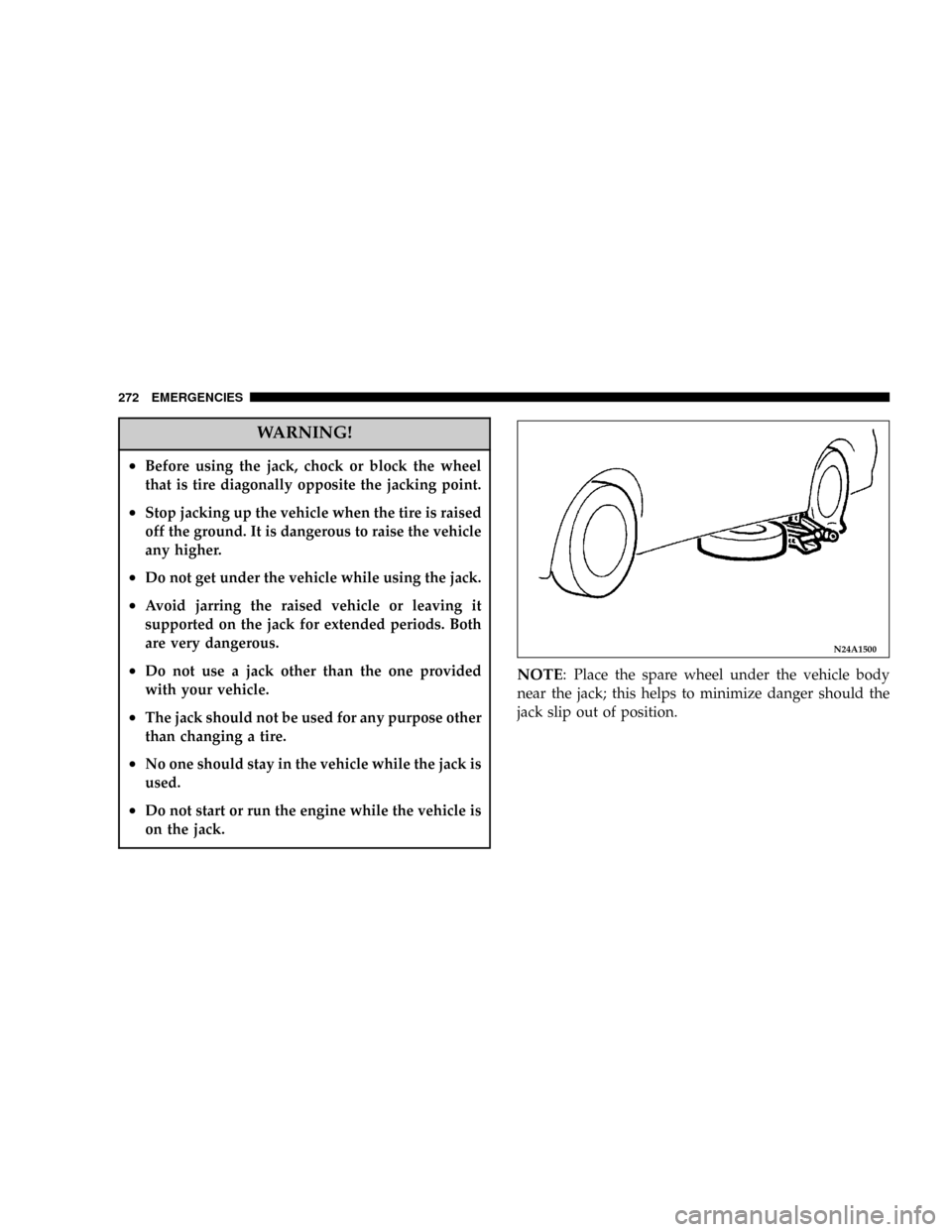
WARNING!
²Before using the jack, chock or block the wheel
that is tire diagonally opposite the jacking point.
²Stop jacking up the vehicle when the tire is raised
off the ground. It is dangerous to raise the vehicle
any higher.
²Do not get under the vehicle while using the jack.
²Avoid jarring the raised vehicle or leaving it
supported on the jack for extended periods. Both
are very dangerous.
²Do not use a jack other than the one provided
with your vehicle.
²The jack should not be used for any purpose other
than changing a tire.
²No one should stay in the vehicle while the jack is
used.
²Do not start or run the engine while the vehicle is
on the jack.
NOTE: Place the spare wheel under the vehicle body
near the jack; this helps to minimize danger should the
jack slip out of position.
N24A1500
272 EMERGENCIES
Page 273 of 394
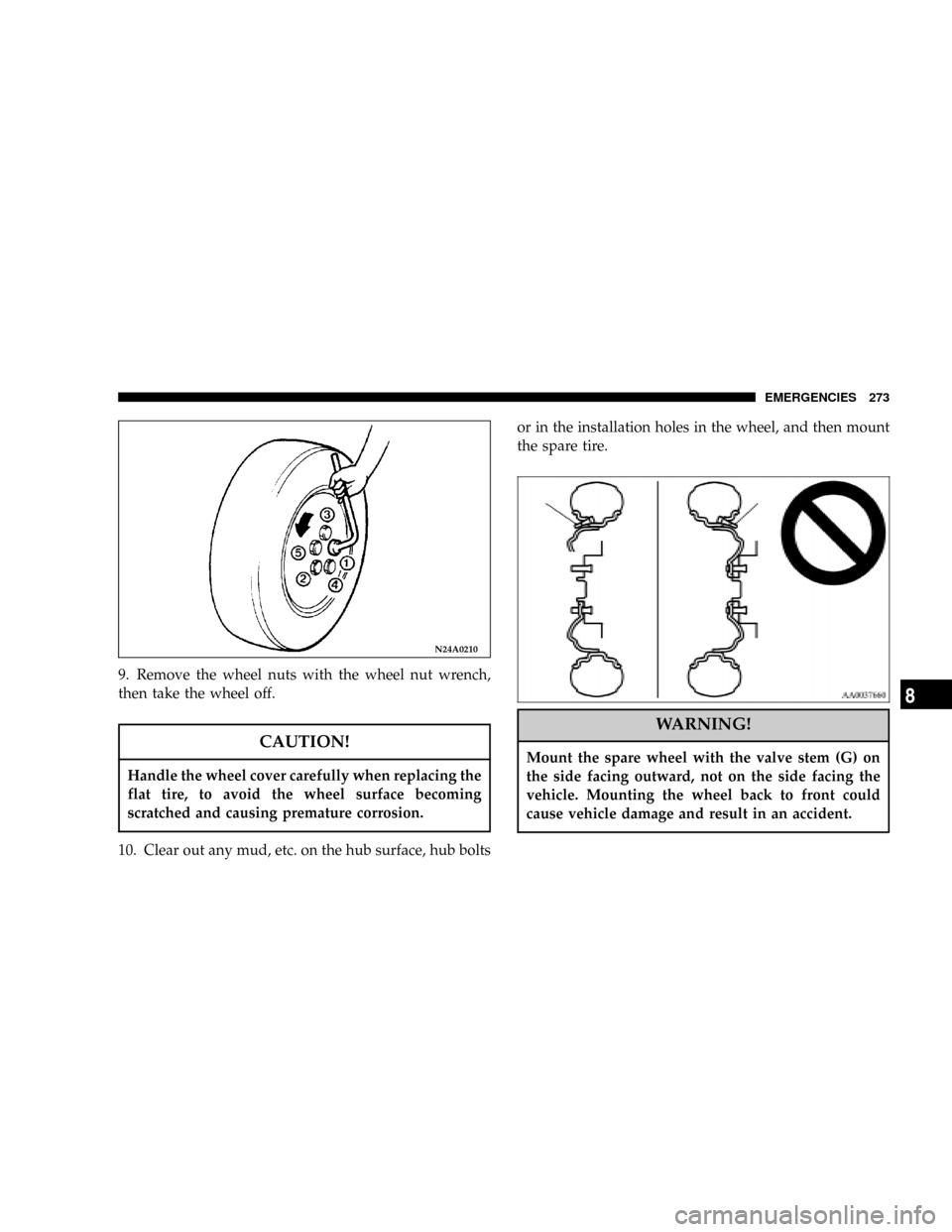
9. Remove the wheel nuts with the wheel nut wrench,
then take the wheel off.
CAUTION!
Handle the wheel cover carefully when replacing the
flat tire, to avoid the wheel surface becoming
scratched and causing premature corrosion.
10. Clear out any mud, etc. on the hub surface, hub boltsor in the installation holes in the wheel, and then mount
the spare tire.
WARNING!
Mount the spare wheel with the valve stem (G) on
the side facing outward, not on the side facing the
vehicle. Mounting the wheel back to front could
cause vehicle damage and result in an accident.
N24A0210
EMERGENCIES 273
8
Page 274 of 394

11. Install the spare wheel with the nut's tapered end
facing inward, then tighten by hand until the wheel is no
longer loose.
CAUTION!
Never apply oil to either wheel bolts or nuts as it can
cause them to overtighten.
NOTE: Flange nuts can be temporarily used on the steel
wheel, but return to the original wheel and tire as soon as
possible.
If all four wheels are changed to steel wheels, use
tapered nuts.
N24A1410
Tapered nut
Flange nut
274 EMERGENCIES
Page 275 of 394

12. Lower the vehicle slowly and then tighten the nuts in
the sequence shown in the illustration until each nut has
been tightened to the specified torque.
88 to 108 N·m (65 to 80 ft lb)
CAUTION!
Never use extra force with your foot on the wheel
nut wrench or a pipe extension as you can over-
tighten the nut.
13. Lower and remove the jack, and store the jack, flat
tire and chock. Have the damaged tire repaired as soon as
possible.
N24A0220
EMERGENCIES 275
8
Page 276 of 394

14. Check tire inflation pressure. Tire inflation pressure
specifications are shown on a placard located on the
driver 's side ``B''-Pillar.
CAUTION!
²The emergency tire is to be used only temporarily
when the standard tire is damaged. Repair the
damaged tire as soon as possible. Replace the
emergency tire with the standard tire.
²After changing the tire and driving the vehicle
approximately 621 miles (1000 km), retighten the
wheel nuts to make sure that they are not loose.
²If the steering wheel vibrates after changing the
tire, have the tire checked for balance at an autho-
rized dealer.
²Avoid mixing one type of tire with another type or
using tires of a size other than the specified size.
Premature mechanical wear and reduced handling
may result.N24A1420
276 EMERGENCIES
Page 277 of 394
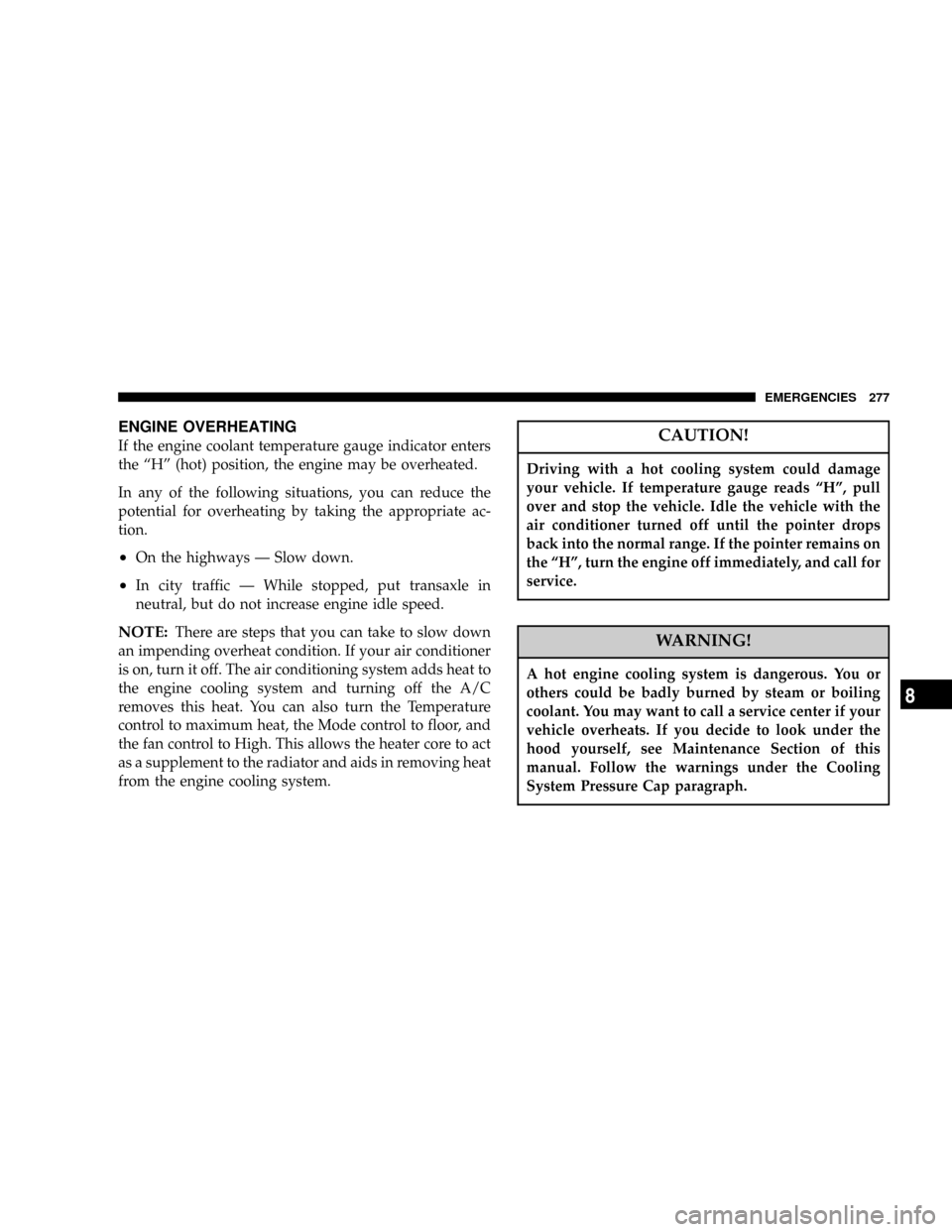
ENGINE OVERHEATING
If the engine coolant temperature gauge indicator enters
the ªHº (hot) position, the engine may be overheated.
In any of the following situations, you can reduce the
potential for overheating by taking the appropriate ac-
tion.
²On the highways Ð Slow down.
²In city traffic Ð While stopped, put transaxle in
neutral, but do not increase engine idle speed.
NOTE:There are steps that you can take to slow down
an impending overheat condition. If your air conditioner
is on, turn it off. The air conditioning system adds heat to
the engine cooling system and turning off the A/C
removes this heat. You can also turn the Temperature
control to maximum heat, the Mode control to floor, and
the fan control to High. This allows the heater core to act
as a supplement to the radiator and aids in removing heat
from the engine cooling system.
CAUTION!
Driving with a hot cooling system could damage
your vehicle. If temperature gauge reads ªHº, pull
over and stop the vehicle. Idle the vehicle with the
air conditioner turned off until the pointer drops
back into the normal range. If the pointer remains on
the ªHº, turn the engine off immediately, and call for
service.
WARNING!
A hot engine cooling system is dangerous. You or
others could be badly burned by steam or boiling
coolant. You may want to call a service center if your
vehicle overheats. If you decide to look under the
hood yourself, see Maintenance Section of this
manual. Follow the warnings under the Cooling
System Pressure Cap paragraph.
EMERGENCIES 277
8
Page 278 of 394
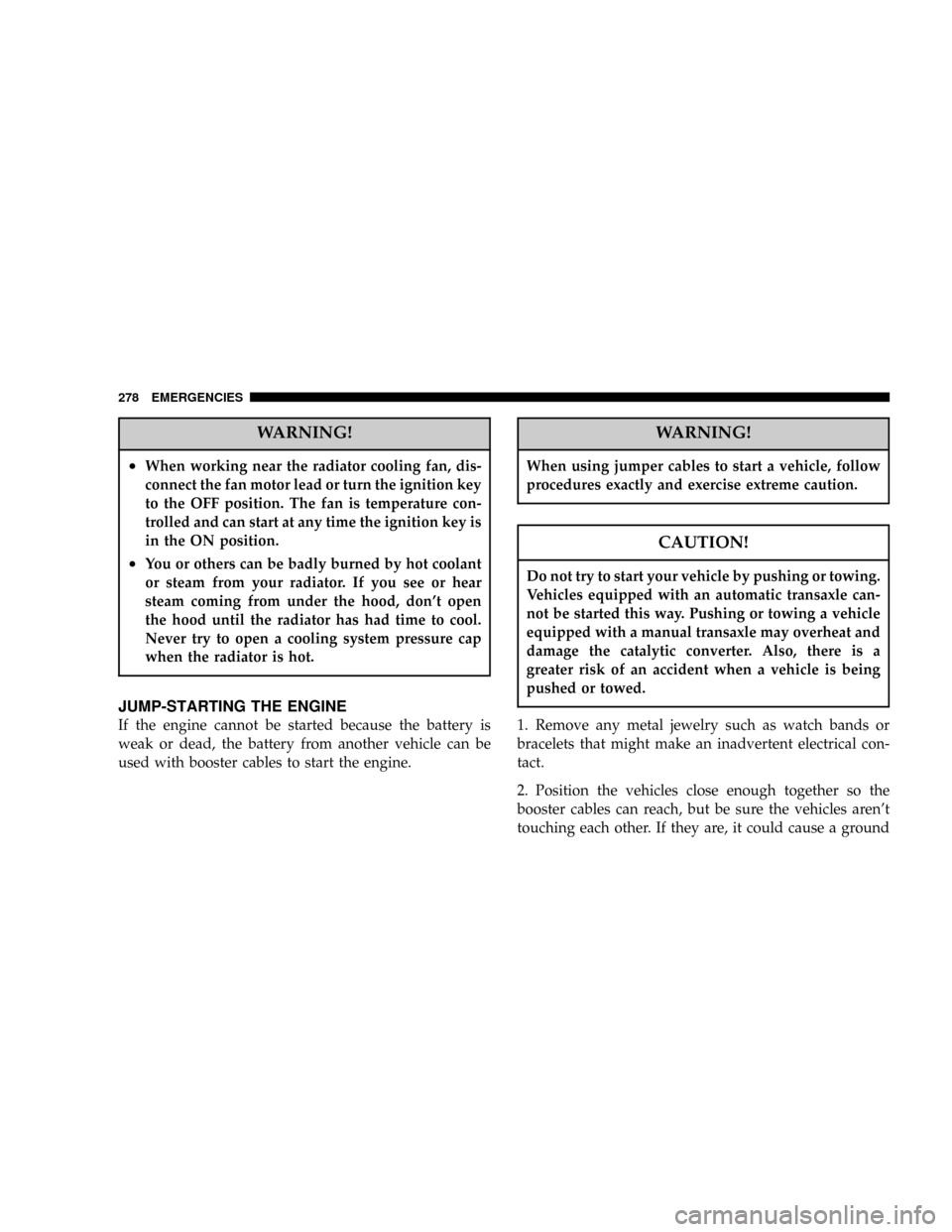
WARNING!
²When working near the radiator cooling fan, dis-
connect the fan motor lead or turn the ignition key
to the OFF position. The fan is temperature con-
trolled and can start at any time the ignition key is
in the ON position.
²You or others can be badly burned by hot coolant
or steam from your radiator. If you see or hear
steam coming from under the hood, don't open
the hood until the radiator has had time to cool.
Never try to open a cooling system pressure cap
when the radiator is hot.
JUMP-STARTING THE ENGINE
If the engine cannot be started because the battery is
weak or dead, the battery from another vehicle can be
used with booster cables to start the engine.
WARNING!
When using jumper cables to start a vehicle, follow
procedures exactly and exercise extreme caution.
CAUTION!
Do not try to start your vehicle by pushing or towing.
Vehicles equipped with an automatic transaxle can-
not be started this way. Pushing or towing a vehicle
equipped with a manual transaxle may overheat and
damage the catalytic converter. Also, there is a
greater risk of an accident when a vehicle is being
pushed or towed.
1. Remove any metal jewelry such as watch bands or
bracelets that might make an inadvertent electrical con-
tact.
2. Position the vehicles close enough together so the
booster cables can reach, but be sure the vehicles aren't
touching each other. If they are, it could cause a ground
278 EMERGENCIES
Page 279 of 394

connection. You wouldn't be able to start your vehicle,
and the bad ground could damage the electrical systems.
CAUTION!
Check the other vehicle. It must have a 12-volt
battery. If the other system isn't 12-volts, both sys-
tems can be damaged.
3. You could be injured if the vehicles move. Set the
parking brake firmly on each vehicle. Put an automatic
transaxle in ªPº (PARK) or a manual transaxle in ªNº
(Neutral). Turn the ignition key to the ªLOCKº position.
WARNING!
Turn the ignition key to the ªLOCKº position on
both vehicles.
Use care to make sure that the cables or your clothes
are never caught by the fan or drive belt. Personal
injury could result.
NOTE: Turn off all lights, heater and other electrical
loads. This will avoid sparks and help save both batter-
ies.
4. Make sure battery electrolyte is at the proper level.
(See ªBatteryº on page 321.)
WARNING!
If electrolyte fluid is not visible, or appears to be
frozen, do not attempt jump starting.
The battery might rupture or explode if the tempera-
ture is below the freezing point or if it is not filled to
the proper level.
EMERGENCIES 279
8
Page 280 of 394
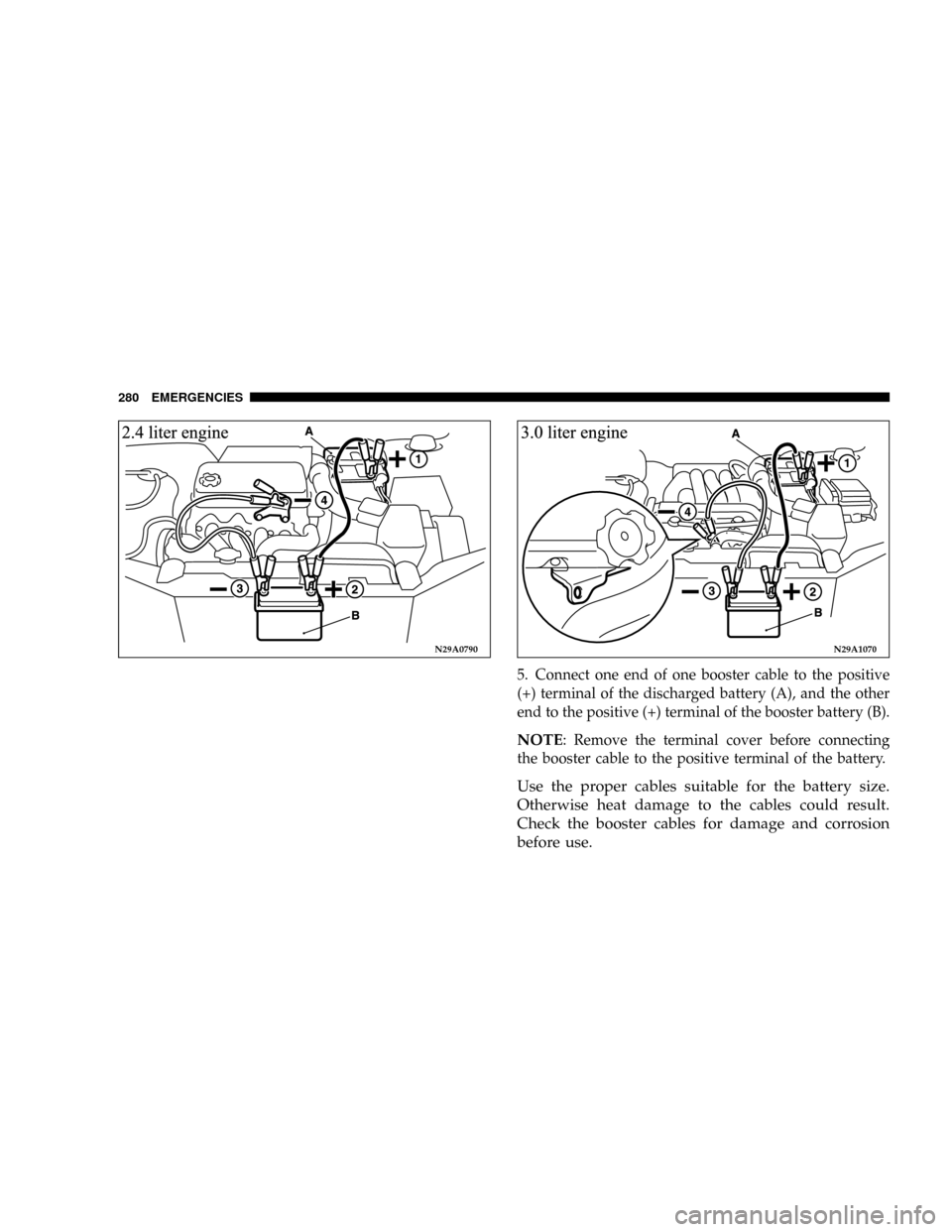
5. Connect one end of one booster cable to the positive
(+) terminal of the discharged battery (A), and the other
end to the positive (+) terminal of the booster battery (B).
NOTE: Remove the terminal cover before connecting
the booster cable to the positive terminal of the battery.
Use the proper cables suitable for the battery size.
Otherwise heat damage to the cables could result.
Check the booster cables for damage and corrosion
before use.
N29A0790N29A1070
280 EMERGENCIES